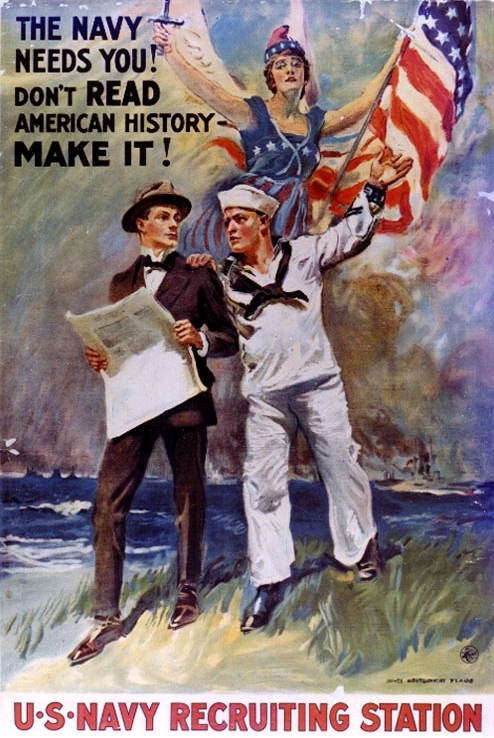America's military power in World War One
America entered into World War One on 7 December 1917, primarily as a result of German’s policy of unrestricted submarine warfare. The troops on the frontline welcomed the arrival of the “doughboys” after the heavy casualties at the Somme and Verdun. Both sides had fallen into a stalemate, so the entry of America’s military power was a turning point in the war.
The Allies saw the American Army as their military saviours. On a visit to Britain in early June 1917, General John Pershing, commander-in-chief of the American Expeditionary Force (AEF), was treated like a king. The 'London Graphic' published a photo of Pershing and his fellow officers with the caption: "Now is the winter of our discontent made glorious by this sun of (New) York."
The relief at America’s involvement is unsurprising considering the increasingly the Allies’ worsening position. German campaign of unrestricted submarine warfare was proving destructive. In February 1917, 470,000 tons of ships had been sunk. By April it had risen to 837,000 tons. Moreover, the chaos in Russia was set to release tens of thousands of German troops for the Western Front. To cap this, the failure of the Nivelle offensive in 1917, led to widespread mutinies in the French Army.

America’s military power was vital in bolstering the Allied force. The United States had a population of 90 million, offering the potential for a huge army. In steel production alone, America produced three times as much as Germany and Austria did. However, America’s economy was not prepared for war.
The British and French armies were responsible for providing the first American troops with weapons and uniforms - ironic considering neutral America had been the provider of war parts for the Allies. The AEF was supplied with French artillery guns (the 75 and 155mm) while the British provided mortars, machine guns, steel helmets and some uniforms.
David Lloyd George later criticised the time it took to mobilise the AEF (American Expeditionary Force). By 31 October the AEF only numbered 6,064 officers and 80,969 men, five months after the 1st Division had landed in France. In roughly the same time span in 1914, the BEF had sent 354,750 men into the field. Nine months after America declared war, there were 175,000 American troops in Western Europe. In the same time span of nine months from 1914 to 1915, Britain had put 659,104 men into the various theatres of war. Thus, although the arrival of American troops greatly increased morale, America played little role in the war effort of 1917.
However, America cannot be too harshly criticised for the lack of momentum. When Wilson declared war America was not prepared to fight. In peacetime, the American army only numbered 190,000 and they were spread across America. Now these men had to be moved to the eastern seaboard, accommodated and then transported across the Atlantic. The French ports and rail network had to be greatly expanded to handle this influx of troops.
Pershing was also determined that his troops be fully prepared for conflict. He refuted Haig and Pétain’s suggestion that the American forces be used as an aid to the weakest parts of the allied defence. Pershing wanted an independent fighting unit that was well-trained and self-contained. Therefore, when the Germans launched their great offensive of March 1918, there was only one American division in the Allied lines, with three divisions in training areas. The series of German offensives from March to July 1918 greatly threatened the French and British armies. Paris was in danger and on two occasions, the British were nearly driven into the Channel. But in all of these attacks, the Americans played little part.
However, America’s importance increased massively in mid-1918. Pershing realised that a different cause of action was necessary. America upped its deployment of troops to France, sending over 584,000 men in June and July 1918. The American merchant marine could not cope with such numbers, so the British merchant fleet was used as well. The German army had almost drained its supply of men and could not hope to match such numbers. By August 1918, there were nearly 1,500,000 American troops in France; Germany could only muster 300,000 youths.
On 18 July 1918, the French launched a major attack against the Germans from the Forest of Villers-Cotterêts. This attack included two American divisions - a total of 54,000 men. The Allies were planning for a major attack in 1919 that would be led by 100 American divisions. Faced with such odds, the Germans could not go on. This resulted the armistice in November 1918 that led to the Treaty of Versailles in June 1919.
Despite the slow start, America’s military power proved invaluable to the Allies in World War One. By entering the war they both boosted morale and provided much needed military strength.
See also: America and World War One
MLA Citation/Reference
"America's military power in World War One". HistoryLearning.com. 2025. Web.
